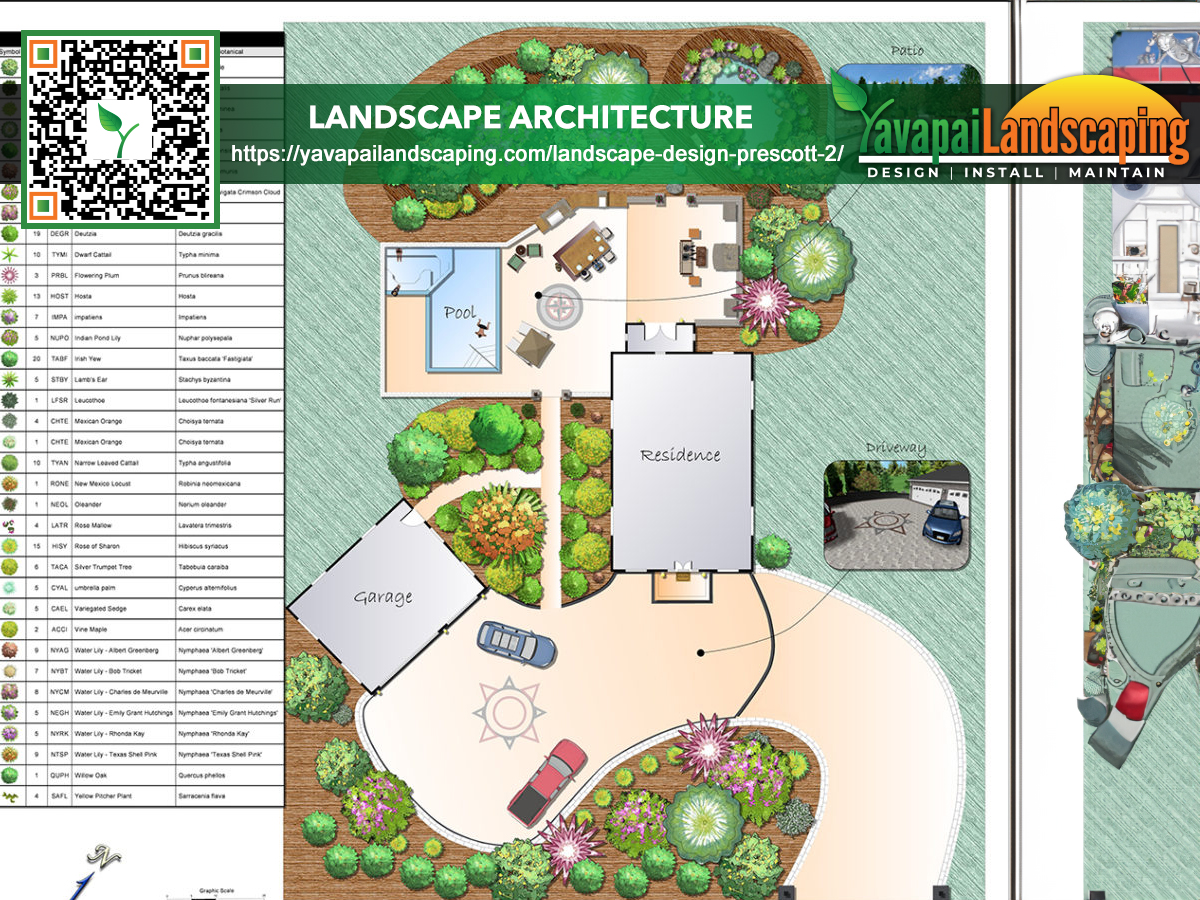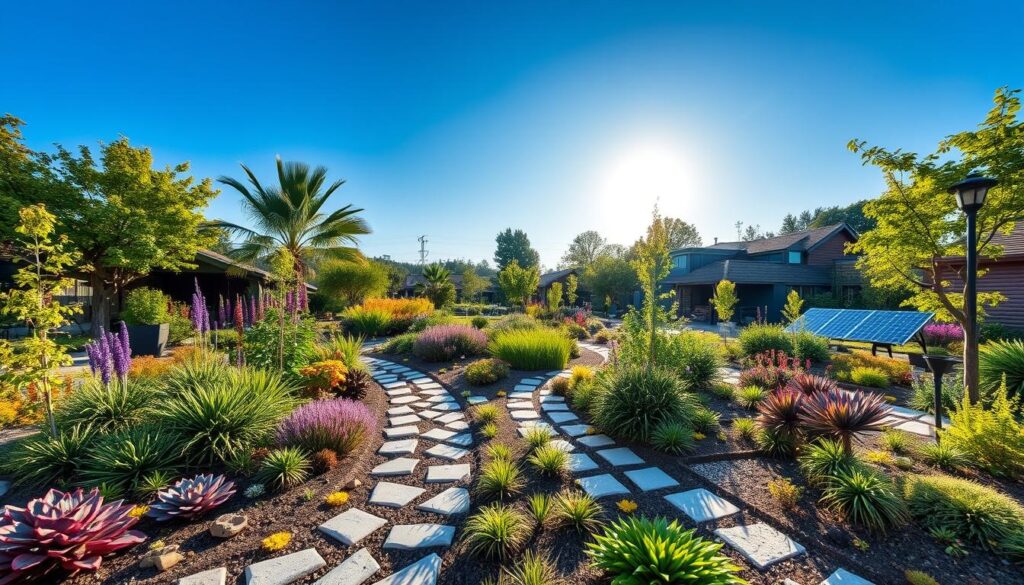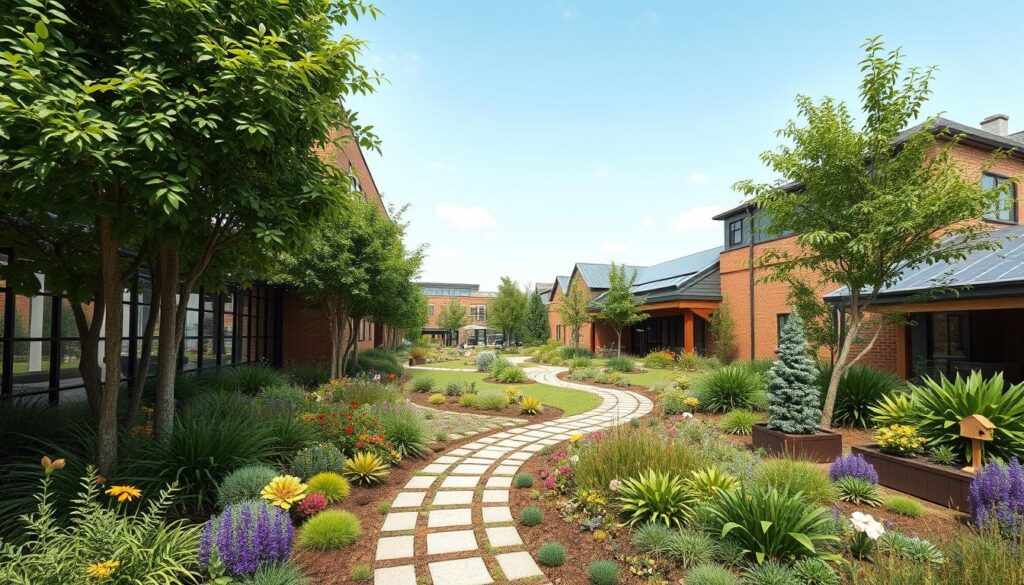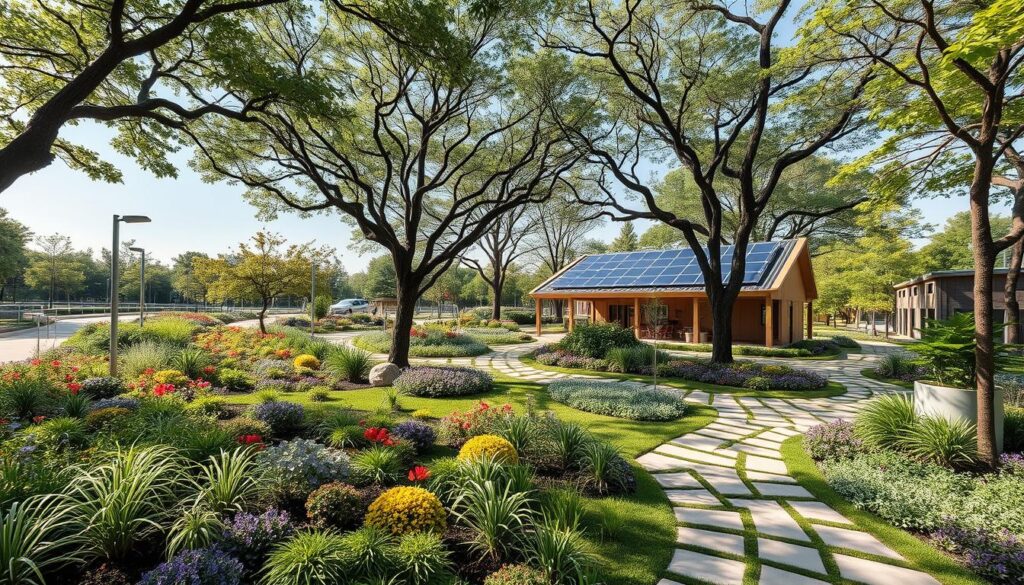
Sustainable landscape design is changing to face our climate’s challenges. As temperatures rise and weather patterns change, landscape architects are finding new ways to adapt. They use eco-friendly landscaping to strengthen outdoor spaces and help nature thrive while saving resources.
Sustainable landscape design is changing our world from city parks to personal gardens. It uses native plants, saves water, and follows design principles that adapt to the environment. These efforts make our surroundings beautiful and help our planet stay resilient against harsh weather and climate change.
Key Takeaways
- Sustainable landscape design focuses on climate change adaptation
- Eco-friendly landscaping techniques promote resilience and biodiversity
- Native plants play a crucial role in adaptive landscape architecture
- Water conservation is a key aspect of sustainable design
- Resilient landscapes help mitigate the impacts of extreme weather
Understanding the Impact of Climate Change on Landscape Architecture

Climate change is changing our world, making landscape architects rethink their designs. They now face new challenges due to rising temperatures and changing weather. This affects how we use outdoor spaces.
Rising Temperatures and Changing Precipitation
Urban heat islands are getting worse as cities get hotter. Landscape architects use shade trees and water features to cool areas. Rainfall is now unpredictable, leading to the need for new water management solutions.
Extreme Weather Events
Storms, floods, and droughts are happening more often. Landscape architects focus on making designs more resilient. They use plants and strategies to protect against severe weather.
Shifts in Plant Hardiness Zones
Plant habitats are changing due to temperature changes. Plants that once thrived in certain areas may not survive anymore. Architects must choose plants that can adapt to new climates to ensure their designs last.
By understanding these changes, landscape architects can create resilient outdoor spaces. These spaces can withstand environmental challenges while being beautiful and functional. This article deserves your attention – read it and be amazed.
The Role of Sustainable Landscape Architecture in Climate Change Mitigation

Sustainable landscape architecture is key in fighting climate change. It uses green infrastructure and sustainable urban planning. This way, landscapes can lessen environmental harm and boost climate resilience.
One big plus of sustainable landscapes is carbon sequestration. Trees, plants, and soil pull carbon dioxide from the air, and urban forests and green areas can balance out emissions from buildings and cars.
Green infrastructure like rain gardens and green roofs tackles stormwater and heat. These features also improve air quality, save water, and support local wildlife.
Sustainable urban planning brings nature into city design. This includes:
- Creating connected green spaces
- Prioritizing pedestrian and bicycle infrastructure
- Designing compact, mixed-use developments
- Preserving and restoring natural ecosystems
Using these methods, landscape architects help cities face climate change and make cities better places to live. Green spaces and sustainable design create strong, livable cities for the future.
Water Management Strategies for Resilient Landscapes
Climate change makes smart water management in landscape design crucial. We must rethink how we handle water for resilient outdoor spaces. Let’s look at key strategies for conserving water and managing stormwater.
Rainwater Harvesting and Bioretention
Rainwater harvesting systems collect and store rainwater for later use, reducing the need for municipal water. Bioretention areas, like rain gardens, filter stormwater runoff.
They remove pollutants and slow water flow, easing drainage system burdens.
Permeable Paving and Green Infrastructure
Permeable paving lets water seep through, reducing runoff. This method helps recharge groundwater and prevents flooding. Green infrastructure mimics natural water cycles like green roofs and vegetated swales.
These features improve stormwater management and add beauty to urban landscapes.
Drought-Resistant Plant Selection
Choosing drought-tolerant landscaping is key to water conservation. Native plants adapted to local conditions often need less water, and succulents and certain grasses thrive with minimal irrigation.
By selecting these plants, we create landscapes that stay lush even in dry spells.
These water management strategies work together to create resilient landscapes. They help us adapt to changing climate patterns while conserving water. By implementing these techniques, we can design outdoor spaces that are both beautiful and sustainable.
Sustainable Landscape Architecture Climate Change: Adaptive Design Principles
Landscape architects are key in making landscapes that can handle climate change. They use climate-adaptive design to make spaces that can change with the environment.

Flexibility is a big part of this. Designers add parts that can change with the weather. These could be things like moving plants or water features that adjust to rain.
It is also important to use nature’s ways. This strengthens landscapes. For instance, making wetlands or rain gardens helps with water and supports local animals.
Choosing native plants is another big part. These plants fit well with the local weather and need less care. They help animals and add to the variety of life in cities.
- Use of permeable surfaces to reduce runoff
- Implementation of green roofs for temperature regulation
- Creation of microclimates to support diverse plant life
Designing for climate change is not just about looks. It’s about picking the right materials, saving energy, and thinking about upkeep. Landscape architects make spaces that last and grow stronger against climate change.
Enhancing Biodiversity and Ecosystem Services in Urban Landscapes
Urban biodiversity is key to making cities healthier. Landscape architects are at the forefront of designing green spaces for diverse lives. These efforts make cities look good and offer essential ecosystem services.
Creating Wildlife Corridors and Habitat Patches
Wildlife corridors help animals move safely through cities. Landscape architects use native landscaping to create these paths. They build a network of green areas, including:
- Rooftop gardens
- Tree-lined streets
- Parks and wetlands
Integrating Native Plant Species
Native plants are vital for local ecosystems. They need less water and care than non-native species. Landscape architects pick plants that:
- Do well in local climates
- Offer food and shelter for wildlife
- Improve soil health
Promoting Pollinator-Friendly Landscapes
Pollinators are crucial for food and ecosystem services. Landscape architects design spaces with a variety of flowering plants. They create gardens in parks, schools, and homes. These gardens have:
- Nectar-rich flowers
- Nesting sites for bees
- Water sources for butterflies
By focusing on urban biodiversity, ecosystem services, and native landscaping, cities can become more resilient and sustainable. These strategies help create vibrant urban ecosystems that benefit both people and nature.
Innovative Materials and Technologies for Climate-Resilient Landscapes
Landscape architects are now using advanced solutions to prepare spaces for climate change. They focus on sustainable materials like recycled plastics, reclaimed wood, and permeable concrete. These materials are durable and good for the environment, helping landscapes be more resilient.
Smart technology is changing how we care for outdoor spaces. New irrigation systems use weather data and soil sensors to save water. They can cut water use by half compared to old methods. LED lights with sensors and timers also save energy in outdoor areas.
Bioengineered soils are becoming a key part of sustainable landscaping. These special soils help plants grow and improve drainage, which is great for cities where soil quality is often poor.
- Photocatalytic concrete that cleans air pollution
- Self-healing materials for longer-lasting hardscapes
- 3D-printed structures using recycled materials
Green roofs and walls are getting better, too. New materials and plants make them work in different climates. They keep buildings cool, reduce pollution, and help wildlife.
As climate issues become more serious, these new materials and tech offer a way forward. They help create landscapes that can handle changing conditions.
Future Trends in Sustainable Landscape Architecture for Climate Change Adaptation
The field of landscape architecture is changing fast to tackle climate change. New trends focus on designs that are both climate-resilient and sustainable. These aim to make spaces that can handle extreme weather while boosting biodiversity and human health.
Smart technology is becoming a big part of landscape design. Sensors and data analytics are used to check soil moisture, air quality, and plant health. This info helps manage resources better and adapt to environmental changes. Designing landscapes that can handle rain, cool cities, and support wildlife is now key.
Another big area is sustainable urban development. Cities are trying out vertical gardens and rooftop farms to add green spaces in crowded areas. These efforts not only clean the air but also help with food security. As climate change affects us, landscape architecture will be vital in creating resilient spaces that support both nature and people.
FAQ
Q: What is sustainable landscape architecture in the context of climate change adaptation?
A: Sustainable landscape architecture is about designing spaces that can handle climate change. It uses strategies to lessen environmental harm and make spaces adaptable. This includes dealing with rising temperatures, changing rain patterns, and extreme weather.
Q: How does sustainable landscape architecture contribute to climate change mitigation?
A: It helps fight climate change by using plants to absorb carbon dioxide. It also uses green spaces and smart urban planning. These methods reduce harm to the environment and make cities more resilient.
Q: What are some water management strategies used in resilient landscapes?
A: Strategies include collecting rainwater, using systems that filter water, and paving that lets water through. These methods make landscapes water-smart and resilient against climate change.
Q: What are the core principles of adaptive design in sustainable landscape architecture?
A: Adaptive design focuses on creating spaces that can change with climate impacts. It uses new ways of planning and adds natural systems to built areas, making spaces more resilient.
Q: How can sustainable landscape architecture enhance biodiversity and ecosystem services in urban areas?
A: It boosts urban biodiversity by creating spaces for wildlife and using native plants. It also supports pollinators. These actions make cities more ecologically resilient.
Q: What innovative materials and technologies are used in climate-resilient landscapes?
A: It uses new materials and tech to make landscapes resilient. This includes smart irrigation and advanced systems that improve landscape performance, helping landscapes adapt to climate change.
Q: What are some future trends in sustainable landscape architecture for climate change adaptation?
A: Future trends include new approaches and technologies for climate resilience. These will shape sustainable urban development and climate-resilient landscapes.
Yavapai Landscaping Prescott offers complimentary estimates for Prescott and its surrounding communities for Landscaping and tree Services. This includes tree removal, trimming, stump grinding, land clearing, storm clean-up, and emergency tree services.
